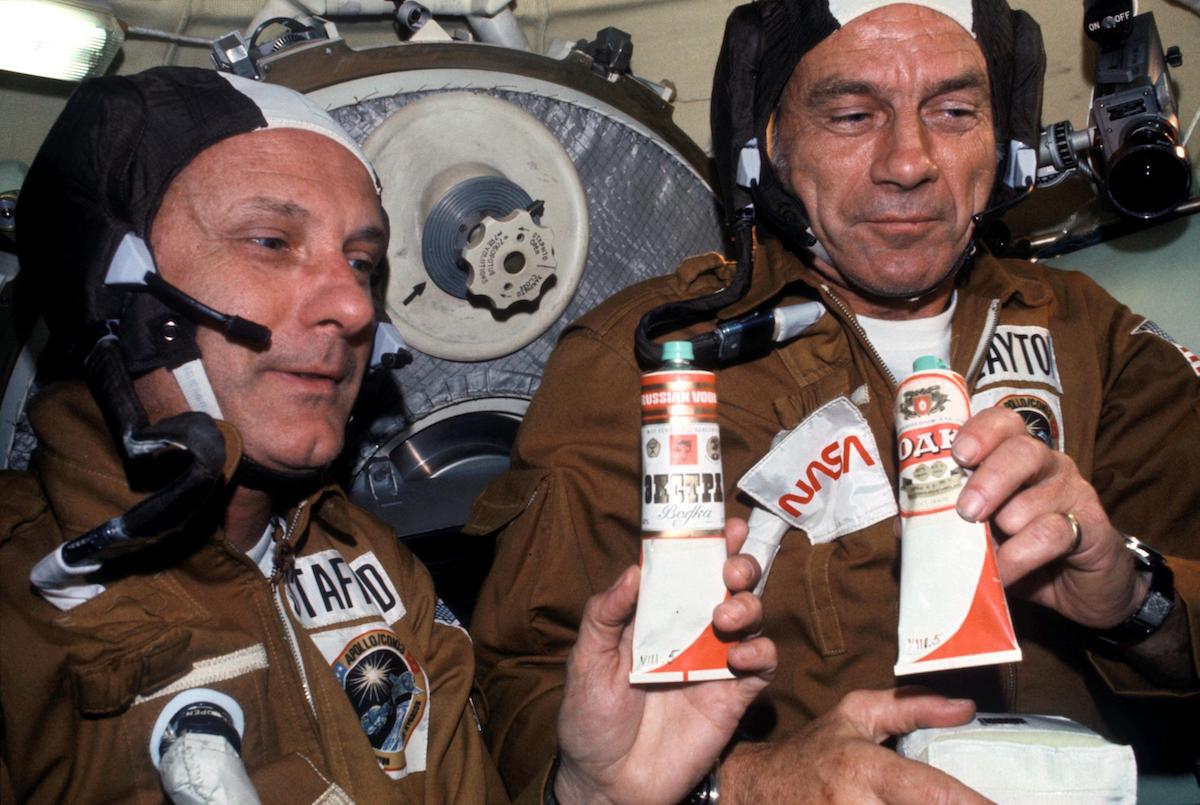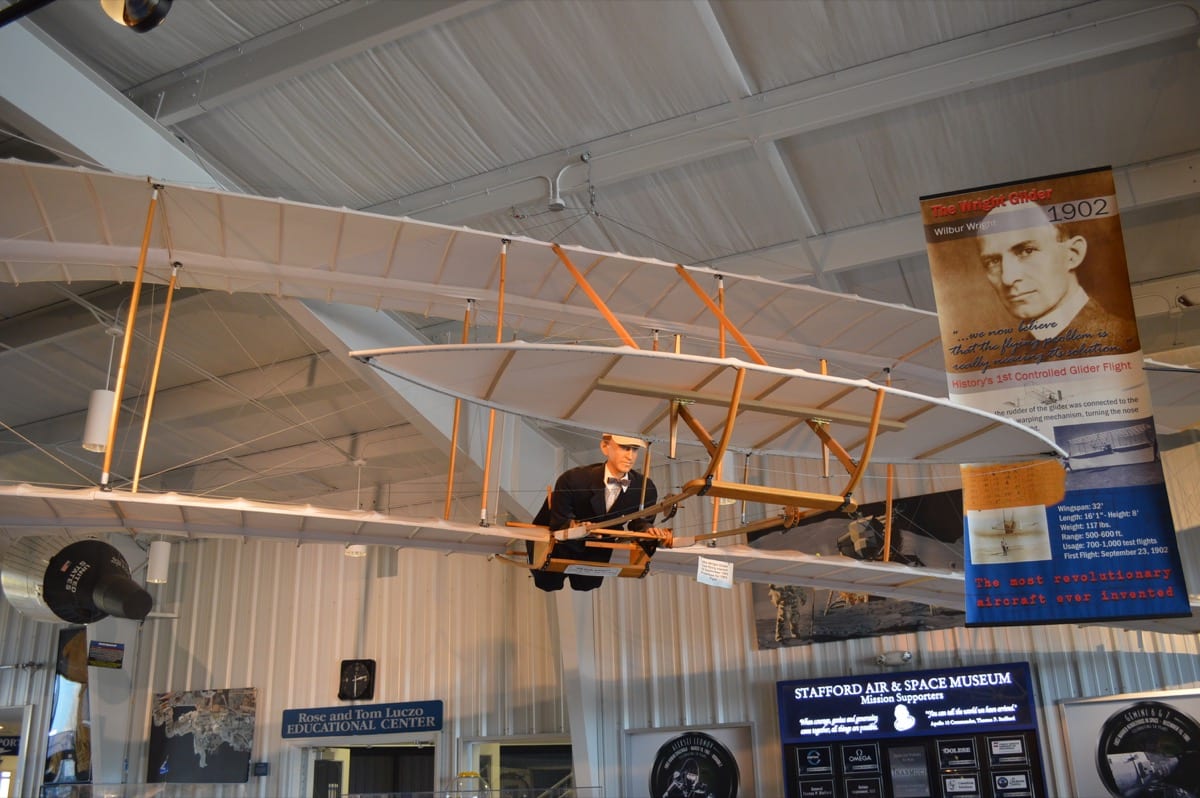Imagine this: A woman who moved to Oklahoma in a covered wagon has a son who grows up to fly to the moon.
It’s not the beginning of an epic movie, but the real life of one of the state’s shining stars, Lt. General Thomas P. Stafford.
Now 87, Stafford finds time every day to touch base with the museum that tells his story — as well as the story of flight — The Stafford Air & Space Museum in Weatherford, Oklahoma.
Just as Stafford came from humble beginnings, so does the museum that bears his name.
From display case to an acre
The museum began as one display case in the Weatherford Airport terminal in the 1960s, according to Chaney Larsen, the museum’s assistant director.
Formally developed as a museum in 1993, it grew to two small rooms in the airport terminal.
Today, the museum has grown to more than acre of exhibits and is gaining regional and national recognition.
Fueling much of that growth, according to Larsen, was Stafford’s connections. Those connections have led to the museum working closely with the Smithsonian Institution, NASA, and the U.S. Air Force to assemble one of the finest collections of aerospace artifacts in the central United States.
In fact, there is so much in the museum’s collection that it is running out of room to display everything.
That’s why the museum is now poised for another period of growth as officials recently kicked off a fundraising campaign to expand the museum by more than 18,000 square feet, increasing its footprint to nearly 60,000 feet.
Called the Legacy Campaign, the funds will be used to make “significant exhibit and artifact additions, along with extensive exterior and interior renovations to the existing building,” according to museum officials.

Almost half of the initial goal of $3 million — $1.4 million – has already been pledged, reports
Jeff DeFehr, the Stafford Foundation’s Building Campaign chairman.
The project kicks off the museum’s 25th anniversary in 2018, with plans to have the shell of the expansion completed in time to host the Apollo 10 50th anniversary in May 2019, museum officials report.
The Legacy Campaign will also upgrade the museum’s offerings, adding immersive, interactive, and high-tech exhibits to bring aerospace history, and the museum’s extensive artifact collection, to life, he said.
The expansion also will increase the available space for events, temporary exhibits, and the museum’s gift shop, as well as a facility to restore important artifacts, such as a Fairchild-Republic A-10 Warthog, and a cockpit of a Boeing B-52 Stratofortress currently awaiting preservation and restoration.
“It is important to do this now, while General Stafford can actively participate in this important campaign, and to enjoy, first-hand, the excitement and impact this museum expansion brings to the public,” DeFehr said.
“This museum is not about me,” Stafford said. “It is dedicated to the American spirit of dreaming the impossible, and making those dreams happen. I grew up in a small western Oklahoma town during the Dust Bowl and Depression, and I flew to the moon. I’m living proof that nothing is impossible!”

Take a tour
While Stafford’s journeys to space are a focus of the museum, it actually is the story of the evolution of flight from the Wright brothers to the moon, according to Larsen.
“In the lobby, we have three main displays: A replica of the Wright glider, a model of the SR71 Blackbird, and then a model of the International Space Station,” she said. “So, you really get to see how fast the evolution of aerospace has been.”

Next on the tour of the museum is a room dedicated to Stafford and his childhood growing up in Weatherford, she noted.
The legendary test pilot and astronaut was among the second group of astronauts selected by NASA in 1962. He flew four historic space missions: Gemini 6, Gemini 9, Apollo 10, and Apollo-Soyuz, three of them as mission Commander.
For his efforts as Joint Commander of the U.S. and Soviet Apollo-Soyuz mission, Stafford received a Nobel Peace Prize nomination. He is the recipient of many prestigious awards, including the Presidential Medal of Freedom, the Congressional Space Medal of Honor, the NASA Distinguished Service Medal, and the Oklahoma Aviator of the Century award.
It’s no surprise that among the museum’s artifacts is Stafford’s actual Apollo 10 pressure suit.

Other artifacts include a 10-story Titan II rocket, an Apollo Command & Service Module, and one of the most impressive collections of rocket engines in the world, including a massive F-1 engine from the Saturn V, a flown Shuttle Main Engine, and a flown segment of a Shuttle Solid Rocket Booster you can walk through.
The museum also boasts the actual Space Shuttle simulator that all 135 crews trained in, Larsen reported.
Aircraft displays include an F-86, F-104, T-33, T-38, F-16, and a rare MIG-21. Full-scale replicas of the Wright Flyer, Bleriot, Spirit of St. Louis, and Bell X-1 are also housed at the museum.

According to Larsen, the museum’s newest outdoor display has already become an iconic monument for the region. Situated just outside the front entrance, one of the most revolutionary aircraft ever built, the Lockheed F-104 “Starfighter,” now points majestically six stories straight up into the sky.
All this in a relatively small western Oklahoma town is often surprising to visitors.
“We have a lot of people who say, ‘you guys are a hidden gem,’” Larsen said. “Or they compare us to the Smithsonian Air and Space Museum, just at a smaller scale. We are a Smithsonian affiliate. We have many items from the Air Force Museum, the Smithsonian, and some of the top-notch museums in the nation, right here in this small western Oklahoma town. Everybody is surprised by the items that we have on display. It’s not what they’re expecting and they’re pleasantly surprised.”

Fly-In
Officials are anxious to entice more general aviation pilots to discover their hidden gem.
“We are connected to the Thomas P. Stafford Airport (KOJA), so people can fly right in,” Larsen said. “If they purchase fuel, they get in free to the museum. That’s definitely an added perk.”
And just last year, the museum launched Wings Over Weatherford, a fly-in that officials say will become an annual event.
Last year’s show featured historic bombers and biplanes that gave rides, as well as at least 20 warbirds, including a B-25 Mitchell, a FG-1D Corsair, the P-51 Mustang “Miss America, a T-28 Trojan, a a WACO ZPF-7 biplane, and the C-47 “Boogie Baby.”
A kid’s zone, a bounce house, and a free train ride rounded out the activities.
One of the first warbird-based events in western Oklahoma, the fly-in attracted nearly 3,000 people, Larsen reported. About 60 general aviation pilots flew in for the show, she added.
Because there wasn’t an airshow, the airport was able to remain open during the event, so GA pilots could fly in all day and take part in the festivities, she noted.
“It was such a success that we already have the date pinned down for this year,” she said, reporting it is Sept. 29, 2018.
Reaching the next generation
The museum is one of the few facilities in western Oklahoma that provides STEM-based tours and camps emphasizing the subjects of Science, Technology, Engineering, and Math.
It received two awards in less than a year for its STEM education activities. In December 2016, the Oklahoma City Thunder and Devon Energy awarded the museum with the “Devon Thunder Explorer’s” Award, and in November 2017, The University of Oklahoma and Devon Energy honored General Stafford and the museum with the “One with You” Award, recognizing the museum as an outstanding STEM education facility.
The museum has partnered with Camp Invention with the National Inventors Hall of Fame for its camps, which are for kids in the first through sixth grades.
“The kids just absolutely love it,” Larsen said. “It’s been a big hit.”
Museum officials are now working to expand the education programs to reach even more ages, Larsen added.

Making it work
While most aviation museums are bolstered by a cadre of volunteers, that’s not the case at the Stafford Air & Space Museum, which is owned and operated by the city of Weatherford.
“We’re special in that we actually only have three full-time staff members who run the entire place, as well as Stafford scholars through Southwestern Oklahoma State University,” Larsen said. “We usually have six to seven students at a time.”
She explained the students vie for a Stafford scholarship, which provides them a job at the museum through their four years of college.
“It’s a really neat program,” she said. “General Stafford himself set it up and has been a big part of it.”
The students study a wide range of subjects, which brings a variety of skills to the museum.
“We have some in the engineering department, some in education, and some in the graphics department,” she said. “We actually hire on graphic students to do our graphic designs for exhibits and everything else that we need.
But while the group is diverse, the staff is still a “very tight-knit family,” she reported. “It’s a neat place to work.”
Need to Know
The Stafford Air & Space Museum is at 3000 E. Logan Road in Weatherford, just off I-40 and Exit 84 on historic Route 66.
The museum is open every day except Thanksgiving, Christmas Eve, Christmas, and New Year’s Day. Hours are 9 a.m. to 5 p.m. Monday through Saturday and 1 p.m. to 5 p.m. Sunday.
Pilots who purchase fuel receive free admission. Other admission prices are $7 for adults, $5 for seniors and active military and veterans, and $3 for students.
Did you know?
Oklahoma, which just celebrated its 110th year of statehood, is the only state to actually have an astronaut in every space program, from Mercury to Gemini, Apollo, the Skylab Shuttle and onward.


